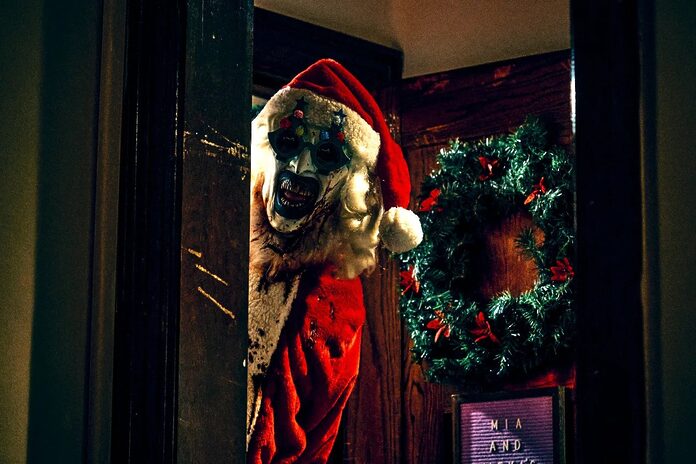The ending of Terrifier 3 is brutal. Like…really brutal. Seemingly, Sienna is left with nothing. So it’s easy to think of the ending as a complete downer, as a pessimistic look at how life is unwinnable. But, and I know this will sound crazy, I actually had the opposite reaction: I was deeply moved by the ending. Because director Damien Leone’s commentary on how we recover from trauma and grief is incredibly palpable and undeniable. And how that ending plays into the Christmastime setting and subsequently sets up Terrifier 4 is incredibly profound—especially because it forces a Christian reading of Sienna’s entire story.
Whoa, that’s a lot to take in. Let’s discuss.
Terrifier 3 ending explained
Who is Art the Clown?
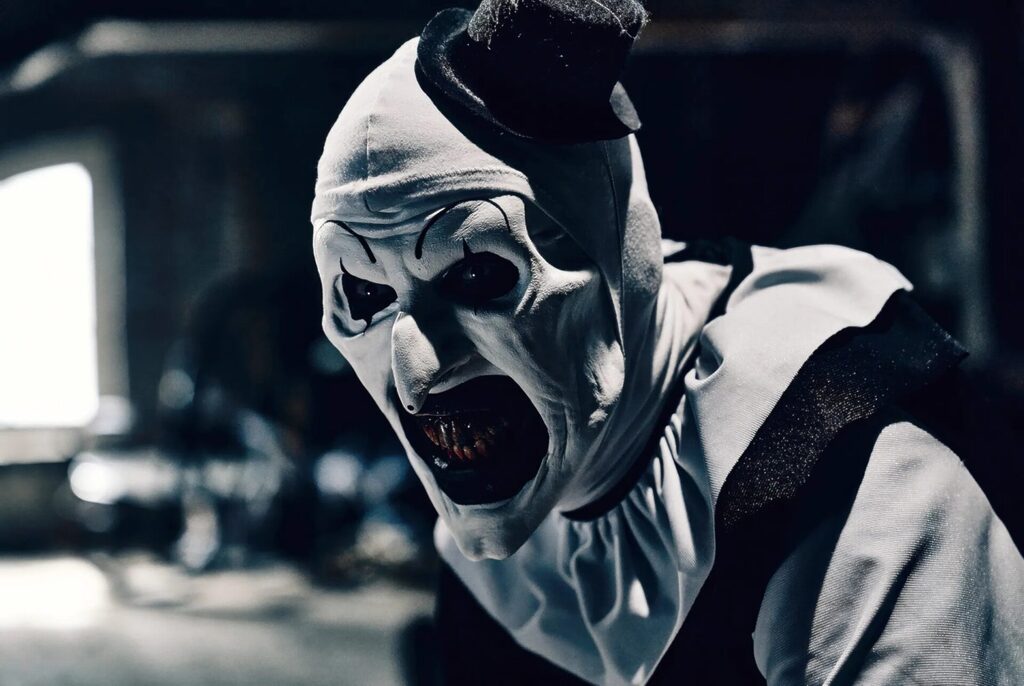
Before we start talking about what exactly happens at the end of Terrifier 3, it’s better to gain a full picture of what the entire franchise is doing (which means spoilers are ahead for the other Terrifier movies), starting with All Hallows’ Eve. This anthology film sets up the lore of Art the Clown in a very specific, postmodern way. Unlike many horror movie killers that are rooted in reality and walk the earth just like we do, such as Michael Myers or Leatherface or Jigsaw, Art the Clown joins the lineage of emblematic villains that represent something more internal.
Often, the symbolism is stated outright: Freddy Krueger represents the power of nightmares and the subconscious mind; Pennywise embodies the exact fears of each individual victim; and Sadako Yamamura pursues anyone who watches a videotape that features the well she was thrown down. In all three cases, we see why the killer exists and what they represent to the characters.
But sometimes the symbolism is a bit more ambiguous. Take “the entity” in It Follows. We know certain details about the monster, like it pursues the last person to have sex in its crazy sex-murder chain. But the movie is more than just a warning about the consequences of sexuality and the passing of STDs. The Entity doesn’t have a single form, and can take on the appearance of anybody.
The inexorable way the monster pursues people like Jay, no matter how far or fast they run, speaks to the inevitability of mortality, the way trauma can “follow” people as they try to recover, often unseen but always present. The Entity’s vague nature and lack of exposition adds to its symbolism, making it more of a conceptual horror, the embodiment of anxiety, more than a concrete one.
As we discussed in our Terrifer 2 breakdown, this is how you should think of Art the Clown. In All Hallows’ Eve, Art is part of three different stories where he wreaks havoc. He shows no mercy to any of his victims, including the children he slays at the end of the film. For one of the short stories, we only see Art the Clown in painting form—which is perfect for his essence.
Art represents…well, art. He is a symbol of something much greater than the clown archetype. He is pure terror incarnate, the embodiment of evil, whose very existence mirrors the unsettling nature of folklore and myth; he is a force of nature, chaotic malevolence, untouched by rationale or morality.
When he writes his name on the wall over the severed heads of the children in All Hallows’ Eve—ART—he is displaying exactly what art is capable of. The genre of horror is special because it takes our deepest fears and anxieties and works them into a narrative where an unstoppable killer comes for us. We see our common stories of mental struggle on screen in defamiliarized form.
How trauma inflicts a community
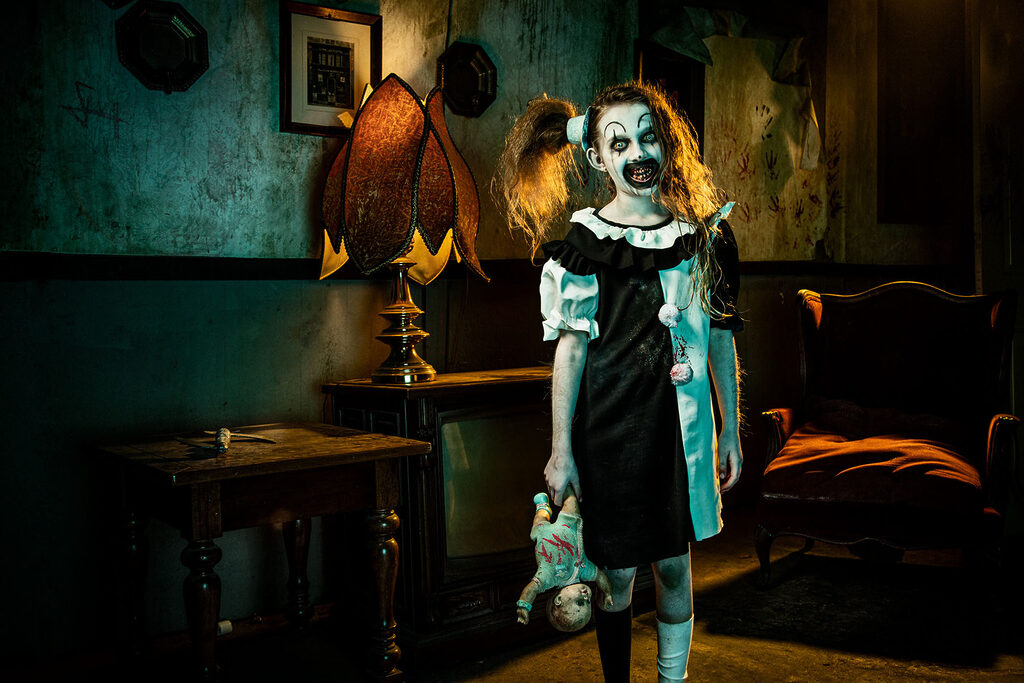
The vicious act of killing two children at the end of All Hallows’ Eve perfectly sets up the rest of the Terrifier franchise. It’s such an unspeakable thing to do, the sort of sin that even the most disgusting of horror villains wouldn’t commit. But Art doesn’t play by our rules. He is not human, and would never feel the sort of emotion we humans would feel for the murder of a child. He exists simply to disrupt, to maim, to overwhelm. Children, in fact, are Art’s greatest asset, because nothing rattles society’s collective psyche like murdering someone so innocent.
This brings in the theme of communal trauma—the sort of storyline we see play out in franchises like Candyman (whose killer forces society to reckon with its history of racial violence) and Ring (whose killer represents how generational trauma gains traction as technology advances). Art became infamous after the Miles County Massacre. Specifically, he’s known for the murder of Emily Crane, whose corpse, whose lost soul wanders Miles County as the Little Pale Girl. She is a walking, ghostly reminder of the hysteria that can grip a community. Individual people didn’t just grieve Emily—an entire community did. An entire community was debilitated by such an unspeakable act.
Terrifier transfers Art’s reckless abandon, his unadulterated contempt for humanity in both child and adult form, to Victoria Hayes, who will serve as the connection between all three Terrifier movies after All Hallows’ Eve. Victoria, who watches her friend murdered by Art in Terrifier, escapes from the killer, but not before being impossibly butchered, with her mangled face becoming unrecognizable. She is now inflicted with irreversible trauma, unable to overcome the terror exacted by Art upon her life and body.
This helps us understand the post-credits scene in Terrifer 2, where Victoria gives birth to Art’s head, as well as Victoria serving as a vessel necessary for Art’s presence in Terrifier 3, all of which furthers the idea of this symbolic killer as a constantly regenerating evil, tying his existence to the trauma of his victims. This act of rebirth represents a cycle of violence and fear, one that Leone employs to ensure that this murderer’s legacy will endure beyond the confines of any single film, any single individual struggle with grief and trauma. Art exists because this story, this collective struggle will always exist. You can’t kill Art—he is within us.
Thus, through All Hallows’ Eve and Terrifier and Terrifier 2, Leone crafted a mythology for Art the Clown that moves beyond the surface-level shock and gore we expect from typical horror movies. Art has, especially after Terrifier 3, taken on a mythic quality, similar to figures like Freddy Krueger or Michael Myers, but with a more artistic, philosophical, existential edge. Art is a representation of something deeply primal, the manifestation of fear itself. His silence, his grin, his merciless cruelty, it all transcends the simple role of a killer: Art is the embodiment of the audience’s deepest, unspoken fears.
Which brings us to Sienna.
Sienna’s struggle with grief
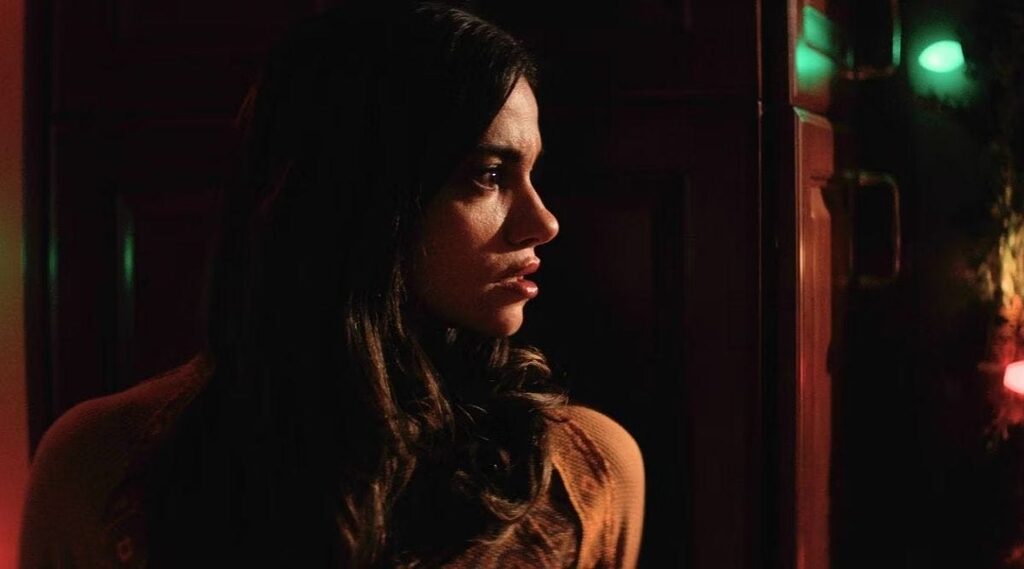
Sienna’s struggle with grief is central to Terrifier 3, and it’s not just her own personal grief—it’s intertwined with the communal trauma that Art the Clown inflicts on everyone around him. Throughout the film, Sienna’s journey is one of a woman deeply haunted by the death of her father and the unresolved pain left in its wake (and Jonathan’s story parallels this). Her father’s mental deterioration, which drove him to envision Art and the horrors to come (much like the husband who painted Art in All Hallows’ Eve) becomes the seed of Sienna’s suffering, manifesting in anxiety, in an overwhelming sense of responsibility.
Given what we’ve discussed about this franchise, we can understand that this grief isn’t just hers to bear. These despicable acts reverberate through the fabric of the community, like a wound that never quite heals. Sienna’s personal grief, therefore, becomes a microcosm of this broader collective suffering. Her father’s descent into madness wasn’t an isolated event, but part of a larger ripple effect caused by Art’s influence.
The horror of Terrifier 3 is not just in the grotesque violence but in how that violence leaves behind emotional and psychological scars that are far harder to heal. Sienna is the perfect embodiment of this struggle—she is simultaneously trying to make sense of her father’s downfall while grappling with her own sense of duty to stop Art. But how do you fight something that is more than just a physical threat, something that represents the darkest corners of human suffering and fear?
Sienna’s battle is as much internal as it is external. The physical confrontations she has with Art in Terrifier 3 are brutal and intense, but the true battle she faces is against the insidious grief that has taken root in her life. Her struggle to overcome this grief mirrors the challenge faced by the community: how do you move forward when the weight of what has happened feels unbearable?
If Art serves as a symbol of the trauma that grips Miles County, then he cannot conceivably be killed, right? Like grief itself, he lingers, waiting for the right moment to strike again, feeding off the fear and helplessness of his victims. How can Sienna possibly win? She’d have to become a warrior—a savior, even.
*Cue the Christmas music*
The Christmas of it all
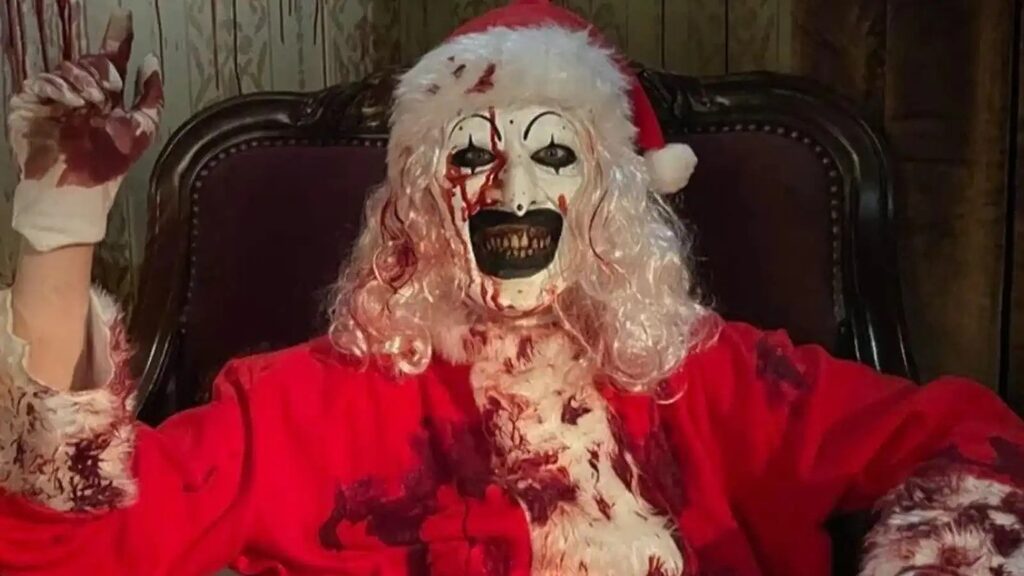
I don’t hesitate in calling Terrifier 3 not only the best horror Christmas movie ever, but the best Christmas movie ever. Part of the reason I say that is for what lies on the surface. Christmastime is treated by Sienna’s family as a time for healing, as a magical period where all our troubles can wash away and we can come together as a powerful unit.
But the power of Sienna’s and the community’s struggle with grief is that trauma isn’t something you simply “get over.” It’s a cycle, much like Art’s repeated resurrections, and it haunts both the individual and the collective. And Terrifier 3 represents the most grueling step in Sienna’s journey thus far, one of confronting this trauma head-on. She’s not just battling the embodiment of evil, but fighting to reclaim her own sense of self, to move past the grief that has defined her and her community for so long.
But, here’s the thing…Sienna doesn’t “win,” does she? The movie ends with her all alone, surrounded by her dead loved ones, having just lost her cousin Gabbie to a hellish pit. She is utterly defeated by this monstrosity that represents her deepest struggle. At the end, it seems grief has won. Christmastime didn’t save her—Art donned the Santa suit and laughed at such an idea. Making Terrifier 3 one of the most honest Christmas movies ever made. The magical holiday season doesn’t stop grief from overwhelming our very being. It’s nothing more than a buffer for the inevitable: you will have to face this monster, eventually.
The ending of Terrifier 3 is nothing more than a snapshot of time. If Sienna had “lost” her battle with grief, she’d be dead at the end. But, in this movie that is completely shaped by the symbolism of its antagonist, her isolation is nothing more than a reflection of her current state, of one of the many battles human beings inevitably lose throughout the course of time in our eternal battle with grief.
All of the people who died in her life are the ones who, in a sense, turned their backs on Sienna. The uncle brushed her psychosis aside and wanted to push her out of the house, and eventually the aunt seems to want to do the same; Jonathan doesn’t want to face the trauma head-on, which is essential for Sienna to move on; and people like Mia just want to capitalize on her suffering.
These people are pieces in a sick game that’s driving Sienna towards a heroic role she must inhabit. The armor and sword mean nothing without the ideology and attitude. She must, as I indicated earlier, embrace the Christ-like narrative that Art has forced her into—to save herself, to save humanity.
The religious narrative of the Terrifier franchise
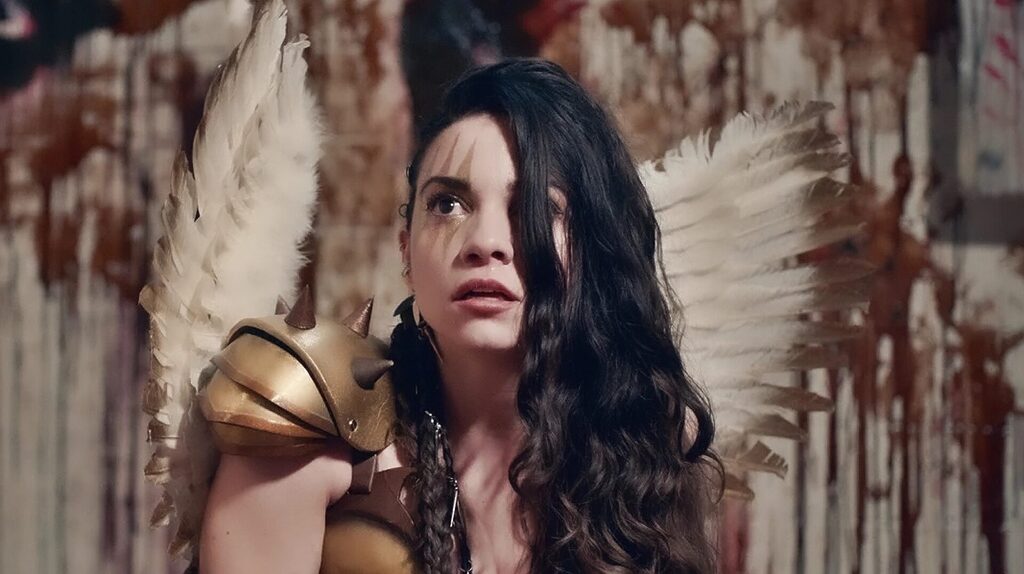
I’m not the first one to notice the Biblical imagery of the Terrifier franchise. Brian Keiper wrote about it back in March 2023, and Cameron Frew updated the analysis to include Terrifer 3—where the religious allegories become much more apparent. In fact, the first person to publicly push this narrative was…Damin Leone himself. In the commentary for Terrifier 2, he notes the Christ-like themes regarding Sienna, how she can’t become a warrior until she’s resurrected (which is what happens in the water tank at the end of Terrifier 2), putting her on the same level as her greatest enemy, Art the Clown.
An essential component of Sienna overcoming her grief (as much as you can “overcome” something that is actually unconquerable) is embracing her role as a savior, which is inherently rooted in religious allegory, particularly drawn from Christian imagery. Suffering, sacrifice, resurrection—it’s all part of Sienna’s story, of any story about trauma. Sienna can’t just be a survivor, but must become a messianic figure.
By confronting her own grief, she effectively confronts the grief that grips the community. And since this is a story, since Art represents the very troubling realities evoked by art, since Leone is building a mythology for our hero, then Sienna confronting her grief isn’t just a personal problem—it’s her destiny. She isn’t just saving herself, but saving the world from Art.
The Biblical imagery in Terrifier 3 is too blunt to ignore. Let’s start with Sienna’s armor and sword, which are inherently steeped in Biblical symbolism. As Frew points out in their article, Leone himself said that when Sienna reached into the cereal box to pull out the sword in Terrifier 2, “that is the moment where the sword officially becomes baptized. It breaks into reality, and the sword is literally on fire.”
The imagery begins to pile up. Sienna’s sword? That mirrors the “sword of the Spirit” that battles evil in Ephesians 6:17. (Also, a Mother Mary figure stands over the forging of the sword in a bizarre dreamlike sequence.) Sienna’s golden armor and angelic wings? Those recall a warrior of God who is sent to battle a demonic force. Sienna’s crown of thorns? A clear allusion to Christ’s suffering during the Passion. These are crucial pieces in Sienna’s transformation, signaling her acceptance of a divine calling…much like Jesus Christ accepting that he’s humanity’s savior.
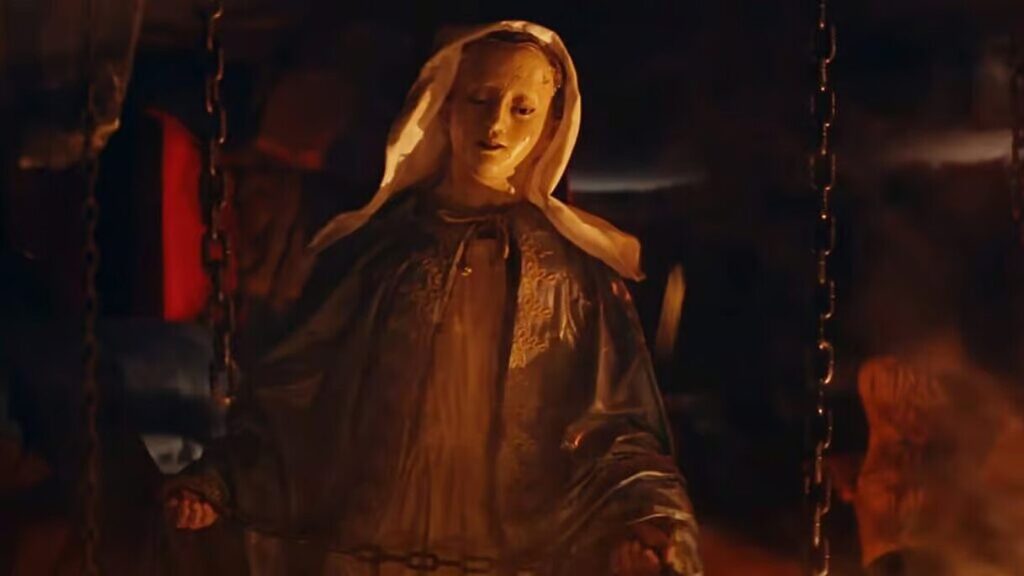
As was the case with Christ, Sienna’s suffering is part of her spiritual journey. The brutal beatings, the symbolic “crucifixion” at the hands of Art, Sienna’s eventual resurrection—it all parallels what Jesus endured. Sienna’s death and miraculous return to life mark her as a figure who must endure pain to overcome the ultimate evil, echoing Christ’s resurrection as a moment of triumph over sin and death.
Art the Clown, in contrast, serves as a Satanic figure, embodying pure, chaotic evil. His repeated resurrections, much like the Beast in Revelation 13:3, suggest he is more than just a killer—he is an unholy force that defies mortality, continuously returning to inflict suffering on the community. His relentless terror and the psychological trauma he spreads symbolize the inescapable grip of evil, making him a representation of communal pain and fear.
This entire reading is effectively backed by Leone, who spoke of Sienna’s father and his daughter’s destiny on the Terrifier 2 commentary track:
“The father was sort of a vessel for that supernatural good that needs to get to Sienna, and he was the one who started getting the visions; not understanding why necessarily or what’s happening, but he knew he had to get the sword for Sienna. He knew that she was meant for something important. And because of that, he was also channeling the bad force that was coming in; the evil entity that was gonna be the counterpart to that good.”
Sienna’s role in this cosmic battle isn’t just personal. It’s about restoring hope to a traumatized community. The residents of Miles County have been paralyzed by fear and grief since the Miles County Massacre. And Sienna’s victory over Art in Terrifier 2 offered the possibility of redemption…until Art was resurrected and she lost in Terrifier 3.
In this sense, the ending of Terrifier 3 beautifully sets up Terrifier 4: Sienna must be resurrected yet again. She must venture down into that pit and retrieve her sword and Gabbie. She must don the armor and face this beast that represents everything she and her community has struggled with for years. In this religious allegory, Sienna, much like Christ, isn’t just fighting to save a small community from Art the Clown—she’s a savior for the entire world. Miles County is just a microcosm of a universal, societal struggle.
The ending of Terrifier 3 might feel like a downer, like there’s no point in moving on. But, really, that low state is just an unavoidable component of trauma and grief. When you get knocked down, you have to get back up. When all is said and done, when you look back on your life and how hard you fought, your triumphs won’t just be parts of the story—they will be essential components of your destiny.
Cast
- Sienna Shaw – Lauren LaVera
- Art the Clown – David Howard Thornton
- Victoria Heyes – Samantha Scaffidi
- Jonathan Shaw – Elliott Fullam
- Gabbie Shaw – Antonella Rose
- Jess Shaw – Margaret Anne Florence
- Greg Shaw – Bryce Johnson
- Michael Shaw – Jason Patric
- Santa Claus – Daniel Roebuck
- Cole – Mason Mecartea
- Mia – Alexa Blair Robertson
- Jennier – Krsy Fox
- Smokey – Clint Howard
- Burke – Chris Jericho
- Written by – Damien Leone
- Directed by – Damien Leone

